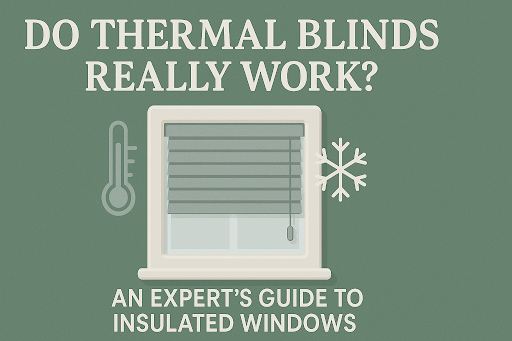With heating costs continuing to rise, homeowners increasingly scrutinize products claiming energy efficiency. This evidence-based guide examines how insulated blinds actually perform, backed by thermal science and real-world testing.
The Science Behind Thermal Insulation
Windows represent the weakest link in home insulation, responsible for 25-30% of residential heating loss. Glass conducts heat efficiently, allowing warmth to escape regardless of wall insulation quality. Thermal blinds address this by adding insulating layers between interior space and glass surfaces.
Effective thermal barriers work through three mechanisms: reducing conductive heat transfer through direct contact, minimizing convective heat movement via air currents, and reflecting radiant heat back toward its source. Quality thermal blinds employ all three principles simultaneously.
Types of Thermal Blind Technology
Cellular Honeycomb Construction
Honeycomb cellular designs create the most effective thermal barriers among blind types. The hexagonal cells trap stationary air pockets that resist heat movement. Air conducts heat poorly when motionless, making trapped air an excellent natural insulator.
Blackout honeycomb blinds combine thermal efficiency with complete light blocking, making them particularly valuable for bedrooms and media rooms. The blackout backing adds density whilst honeycomb structure provides insulation, creating dual-function window treatments that regulate temperature and light simultaneously.
Single-cell honeycomb blinds achieve R-values around 2-3, whilst double-cell versions reach 4-5. For context, standard windows rate R-1 to R-3 depending on glazing. Adding quality cellular blinds can effectively double window insulation.
Thermal-Backed Roller Blinds
Roller blinds with specialized thermal backing offer simpler alternatives to cellular designs. The backing typically consists of metallized or foam-based materials that reflect heat. These work particularly well for solar heat reduction during summer months.
Thermal roller blinds suit kitchens and bathrooms better than cellular options because smooth surfaces resist moisture and clean easily. The trade-off involves slightly reduced insulation performance compared to honeycomb structures.
Multi-Layer Roman Blinds
Roman blinds gain thermal properties through interlining layers. Quality thermal Romans feature three distinct fabric layers: decorative face fabric, thermal interlining, and backing material. This construction creates similar air-trapping benefits to cellular blinds whilst maintaining traditional aesthetic appeal.
The effectiveness depends heavily on fabric density and interlining quality. Budget thermal Romans might feature only two thin layers, providing minimal actual insulation benefit beyond standard fabric.
Patterned and Decorative Options
Modern thermal blinds aren't limited to plain designs. Geometric blinds now incorporate thermal backing and cellular structures, combining energy efficiency with contemporary aesthetics. These patterned options allow homeowners to maintain design preferences whilst gaining insulation benefits, proving thermal performance doesn't require sacrificing style.
Measurable Performance Results
Independent testing reveals significant performance variations between blind types and quality levels. Quality honeycomb blinds reduce heat loss through windows by 35-45% compared to bare glass. Thermal roller blinds achieve 20-30% reductions, whilst standard fabric blinds only manage 10-15%.
These percentages translate to real energy savings. A typical UK semi-detached home with 15 square metres of window area might lose £200-300 annually through windows. Installing quality thermal blinds throughout could save £70-135 yearly. Payback periods range from 4 to 8 years depending on blind quality and heating costs.
Summer cooling benefits prove harder to quantify but remain substantial. South-facing rooms with thermal blinds stay 3-5°C cooler during hot weather, potentially eliminating air conditioning needs in moderate climates.
Installation Factors Affecting Performance
Thermal blind effectiveness depends critically on installation quality. Gaps around blind edges allow convective air currents that negate much of the insulation benefit. Side channels that seal blind edges improve performance by 15-20%.
Mount blinds as close to glass as possible to minimize the air gap between blind and window. Larger gaps allow convective currents that transfer heat despite blind presence. Recess mounting generally outperforms face mounting for thermal efficiency.
Ensure blinds fully cover glass and extend slightly beyond frames. Even small gaps at top or sides create thermal bridges that leak heat. Some homeowners add magnetic strips or Velcro edges to create tighter seals, further improving performance.
Seasonal Optimization Strategies
Maximize thermal blind benefits by adjusting usage seasonally. Winter strategy involves closing blinds before sunset to trap interior heat. During sunny winter days, open south-facing blinds to capture passive solar heating, then close them as temperatures drop.
Summer strategy reverses this approach. Keep blinds closed during peak sunshine hours, especially on south and west-facing windows. The blinds reflect solar heat before it penetrates rooms, reducing cooling requirements. Open blinds during cooler evenings to allow heat escape.
Reflective or light-coloured exterior surfaces enhance summer performance by bouncing solar radiation away. Dark interiors absorb and radiate captured heat, benefiting winter warmth retention but hindering summer cooling.
Comparing Thermal Blinds to Alternative Solutions
Secondary Glazing
Secondary glazing provides superior insulation (R-values 3-5) but costs significantly more and appears less attractive. Thermal blinds offer better value for moderate climates where extreme insulation isn't essential.
Heavy Curtains
Thermal curtains with proper linings achieve similar insulation to roller blinds whilst offering more dramatic aesthetic impact. Blinds suit smaller windows and spaces where curtains would overwhelm room proportions. Combining both maximizes insulation in extreme climates.
Window Film
Reflective window films excel at solar heat rejection but provide no insulation benefit during cold weather. Films cost less initially but can't be removed seasonally like blinds for passive solar heat gain.
Replacement Windows
Triple-glazed windows deliver best thermal performance but cost £500-800 per window versus £50-150 for quality thermal blinds. Blinds make economic sense for homeowners not planning window replacement soon.
Realistic Expectations
Thermal blinds significantly improve window performance but can't transform single-glazing into triple-glazing equivalent. Expect modest rather than dramatic energy bill reductions. The comfort improvement often exceeds measurable savings-eliminating cold spots near windows and reducing draughts creates noticeable differences regardless of thermostat readings.
Properties with poor wall insulation won't see dramatic savings from thermal blinds alone. Address wall and loft insulation first, then add thermal window treatments for comprehensive efficiency. Blinds work best as one component within broader insulation strategies.
Material Quality Matters
Premium thermal blinds justify higher costs through superior materials and construction. Budget honeycomb blinds might use thin plastics that conduct heat more readily than quality fabrics. Check cell depth-deeper cells (25-35mm) outperform shallow designs (10-15mm).
Thermal roller blind backing quality varies enormously. Metallized coatings reflect heat better than foam alternatives. Some manufacturers exaggerate thermal claims for standard fabric blinds-request R-value data or independent testing results.
Maintenance for Continued Performance
Thermal properties degrade if blinds become damaged or dirty. Vacuum cellular blinds monthly to prevent dust accumulation within cells, which reduces insulating air pockets. Inspect for holes or tears that create air leakage paths.
Clean thermal roller blind backing gently to preserve reflective coatings. Harsh chemicals or abrasive cleaning can damage thermal properties whilst blind appears superficially fine.
The Verdict
Thermal blinds genuinely work when properly selected and installed. Quality honeycomb designs deliver best performance, justifying premium costs through measurable energy savings and improved comfort. Thermal roller blinds suit moisture-prone areas whilst providing moderate insulation benefits.
The financial case strengthens in properties with single-glazing or older double-glazing, where percentage improvements prove largest. Modern triple-glazed windows already perform well, making thermal blinds less critical though still beneficial.
Consider thermal blinds essential for energy-conscious homes rather than optional accessories. The combination of modest energy savings, enhanced comfort, and aesthetic improvement creates compelling value propositions. While not miracle solutions, quality thermal blinds represent practical investments that deliver consistent benefits for 10-15 years.
Start saving on energy bills today. Explore our full range of thermal blinds at 1clickblinds.co.uk and find the perfect insulation solution for your home.






